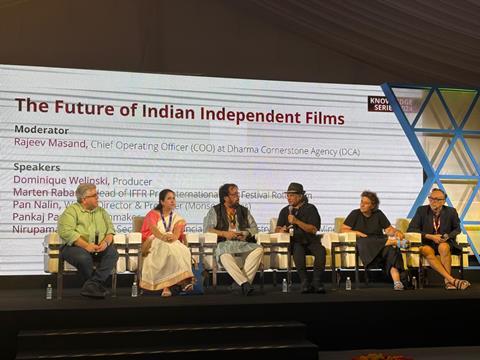
At a Film Bazaar panel in Goa, filmmakers including Pan Nalin and Pankaj Parashar talked about the tough climate for indie films in India, and international experts such as Marten Rabarts and Dominique Welinski pointed to global demand for Indian voices.
“Our films need to work in theatres and on streaming platforms in India and then across the world,” Nalin said at the November 21 panel discussion organised as part of Film Bazaar’s Knowledge Series.
“It’s easy to make an independent film but after that, it’s complete darkness. It’s tough to get it out there.”
Nalin bemoaned the high costs of releasing a film in India, as well as exhibition taking a larger cut of the ticket sales compared to other parts of the world.
“How do we release an independent film in such a situation? Because the money will never flow back to the so-called independent film network.”
Director Pankaj Parashar (Jalwa, Chaalbaaz in London) chimed in to comment on the system of distribution in India which is handled state by state, as opposed to countrywide.
“If you release a film in a particular territory like Delhi and it doesn’t do well, then all the other distributors clam up. They don’t want to touch it,” said the director, who added that there are not enough distributors working with independent cinema.
He added that piracy was also a big issue in India. “Your film is out for three or four days and then the piracy happens so there is only the first three or four days to cash in.”
Streaming landscape
The panel, addressing the overall topic of the future of independent film in India, was particularly enraged by streamers who broke “their promise” to find a home for the country’s independent cinema.
“When Netflix first came to India in 2016, we were very hopeful,” said Nirupama Kotru who is joint secretary in India’s Ministry of Culture. “Now there is a real problem with content formula. There’s only a couple of formulas they want and so everybody is making the same bad thing.
“And the star [system] is such a curse. [Streamers] just want stars now and so the whole purpose is lost,” she continued. “They had a promise and somehow they have failed.”
Nalin added that streamers have started following the “old studio system” and it has become “very tough” to make back the budget from a streaming deal.
“We have to find a way to extract more money from the streamers,” he urged.
The filmmaker used his 2022 Oscar-shortlisted feature Last Film Show as an example. The film was released theatrically in a handful of Western countries to drum up publicity and credibility. “Three weeks later it went on Amazon Prime in Spain and we got a much better price and better viewership.”
Government support
Elsewhere, panellists called on the government to provide more support for the independent sector including the lowering of tax.
“The entertainment tax is the highest in the world and the government gets about a billion and a half dollars from this industry,” Parashar claimed. “Please give it back to the industry so independent filmmakers can keep making films.
“The NFDC [National Film Development Corporation of India] needs to try and get more funds from the government,” the director added. “There needs to be more money allocated to independent filmmakers.”
French producer Dominique Welinski also urged more government support so that independent filmmakers do not have to rely on European co-productions.
“The market for independent Indian film is good but it would be better served by being supported locally and being able to be produced locally,” said Welinski, who runs the Factory programme at Directors’ Fortnight in Cannes.
“Of course [European producers] can help and we do our best. But we have to find the directors and it’s a long process. I’m sure most of the films could be produced in India alone if there was some more support there from the state. Then, the market will be fully open for independent Indian films.”
Marten Rabarts, head of industry at International Film Festival of Rotterdam (IFFR), also reinforced the international desire for Indian films.
“The success of something like [Payal Kapadia’s] All We Imagine As Light increases the possibility of your film being selected for a festival and finding distribution,” he said, pointing to IFFR’s record selection of 16 Indian films for its 2025 edition.
“It’s driven a kind of fever for Indian cinema right now. There’s a real interest for it so [Indian filmmakers] should use this opportunity and keep pushing.”
























